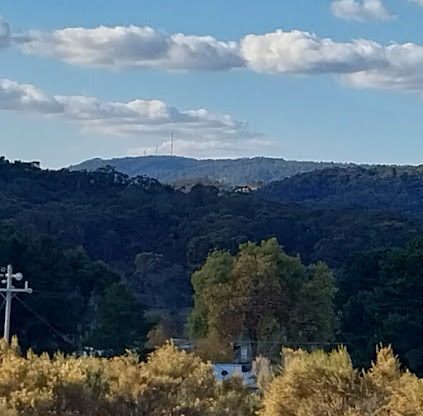Samuel Calvert's etching of Mt Alexander, 1862. Fact or Fiction?
There are a number of versions of this etching by Samuel Calvert. It's not known when this colourised version was made but we know that an uncoloured version was published in 'News Letter of Australasia', November 1862 and another version published in the 'Melbourne Post', December, 1862. All versions or editions have been sourced from the National Library of Australia.
The print shows Mt Alexander framed between two hills with what appears to be a stream in the foreground with people engaged in some activity by the water's edge, perhaps fishing. The title of the print is 'Mount Alexander, from near the Railway' so we've been given an important clue, the Melbourne to Bendigo railway line having just been completed in that year.
Mount Alexander appears very close to the artist here and so the railway line at Harcourt seemed a good place to start searching for the artist's vantage point. (It's most likely that an unknown and uncredited artist provided a sketch to Calvert for etching). In actual fact there are relatively few places where a view of Mt Alexander, at least like the one in Calvert's etching, can be seen from the Melbourne to Bendigo Railway line. Lines of hills all along the track tend to obscure such views and it soon became apparent that the views to the mountain (see photo below) at Harcourt failed to match that of the art work.
View towards Mt Alexander from near Harcourt Viaduct
Recently, by chance, I was driving along a back street of Chewton, east of Castlemaine and south of Harcourt, when a vista opened up much more like the view in the print. (The railway line is a short distance to the south at this point).
View towards Mt Alexander from Old Post Office Hill, Chewton
We can see here that the Forest Creek valley provides an excellent frame for a view towards Mt Alexander. The hills on either side of this valley were likely to have been completely denuded during the gold rush years such was the demand for timber for shoring up mine shafts and fuel for heating and cooking, so quite possibly much more of the mountain would have been visible before the forests grew back.
This leaves the problem of the creek shown in the etching. Forest Creek does flow at the bottom of the hill here but, at about this point, turns northwards to flow up the valley shown. Even by the late stage of the rush in 1862 I feel sure the creek would have been a series of mud holes still being worked by gold fossickers and puddlers in the hope that gold could still be discovered in one of the richest alluvial goldfields the world had ever seen. The idea that people might have enjoyed picnicking and fishing along its muddy banks seems far fetched.
There are definitely discrepancies between the reality of Mt Alexander and the artist's view (the mountain does indeed slope suddenly to the right of photo, but this is hidden by the hill on that side). However I think we can safely conclude that the etching captures a degree of truth which is still able to lead to some interesting conclusions which I will deal with in a subsequent post.
Here is a photo of Mount Alexander taken a bit higher up the left hand side hill in the middle distance. It reveals more of how it might have appeared to the artist from the viewpoint chosen.






Comments
Post a Comment